Matthew Loux on the Eternal Beauty of ’90s Videogames, Evolving Your Aesthetic and The Time Museum
Comics Features Matthew Loux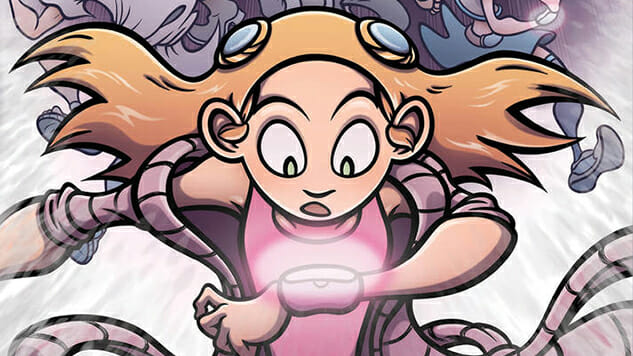
Cartoonist Matthew Loux is probably best known for his five-book Salt Water Taffy series, which revolves around two brothers exploring the small town of Chowder Bay—it’s also the best thing to happen to Maine since Stephen King. With his new project The Time Museum debuting next week from publisher First Second, he’s aiming for a slightly older reader, adding color, elaborating on character design and shifting to a female protagonist—you know, to make things easy on himself. The narrative introduces a cast of six teens from different time periods and the titular institution, which reflects Loux’s adoration of international museums.
The creator not only discussed his process on The Time Machine with Paste, but was also nice enough to list his favorite works of art involving time travel.![]()
Paste: First, give me the rundown on how you made your way to comics. Did you grow up drawing? When did you decide you wanted to pursue it seriously?
Matthew Loux: I grew up drawing ever since I can remember, and Friday art classes as early as first grade were something I looked forward to all week. Drawing was often the only thing I would do without being forced to, and I recognized early that it was the only thing I was good at. I was also very lucky because I had two parents (still do) who always valued artistic expression and never stopped encouraging my interest in it. I think it was never even a question that I would pursue some sort of art seriously, but it was during high school when I really began to develop my technical knowledge of art. After going to college at the School of Visual Arts, I decided to try comics, despite having been an illustration major. I had taken a few cartooning classes, but not many, so I just winged it. I did some mini comics and bugged Oni Press until they gave me a job and that’s how I started.
Paste: What kind of job?
Loux: I’m just kidding! I got their permission to submit my work to them, and after a while they asked me to try out as an artist for their book F-Stop, written by Antony Johnston, which became my first professional comic job.

The Time Museum Interior Art by Matthew Loux
Paste: It seems like SVA and the Center for Cartoon Studies are the big two in the field, as far as comics higher education (with the Sequential Artists Workshop in Florida being the third leg on the stool). Do they have a rivalry?
Loux: I honestly have no idea. I went to SVA in the late ‘90s and didn’t major in cartooning, and to be honest CCS and any other school that offered it was completely off my radar. Back then, we used to joke that Parsons was our rival, being another big art school in the same neighborhood of Manhattan. We always wanted to try and challenge them in the only sport some of us played—weekly kickball.
Paste: Are there specific technical lessons you learned at SVA that you have applied to your comics work?
Loux: I can’t really name anything specific, but just being able to immerse yourself in art all day and night created a setting that can make you think that anything is possible. During this time I took everything I was being exposed to and, in a lot of ways, the art that others were doing and showing me, and drew ideas from all that. I guess to be perfectly honest, most of the stuff I learned from SVA—and I did learn things—I can’t really apply to comics in a direct way, at least with the kind of work I do. But I went to SVA before Photoshop classes were mandatory, and I was an illustration major. Probably the most valuable thing about art school was the community it created for me.
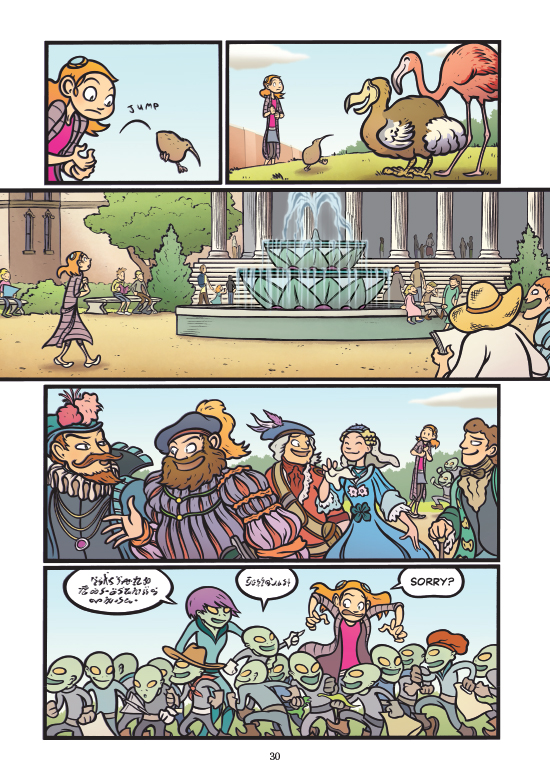
The Time Museum Interior Art by Matthew Loux
Paste: Did you grow up reading comics? Which ones? I’m curious what exactly made you want to try making them. And did you just dive in once you decided that? What was the first comic you made?
Loux: When I was young I really loved Garfield. I appreciated the sarcasm of those strips. My grandmother also was an avid yard sale shopper, and got me dozens of those old paperback collections of Peanuts, and I read them over and over. The earliest comics I remember making were based on Woodstock and Snoopy. I was very young, maybe six or seven. When I was a preteen, I got into Marvel and Image comics, more for the exciting art and characters than for their stories, though. I tried drawing a superhero comic or two, but the level of skill it took to match that stuff was well beyond me at that time. In high school I got very into anime and manga and that opened my eyes to stories and aesthetics that felt so different and cutting edge, that my little mind was blown. Things like the juxtaposition of a seemingly simple, even cartoonish, style that is mixed with such observation, detail and awareness of compositions both for characters and backgrounds. I never really tried to do my own manga styled comic, and frankly I’m glad, but once in my high school art program, then at SVA, my focus shifted to technique and realism.
At the same time I was enjoying all of the really interesting indie comics (of which Oni was a favorite publisher), and the new direction of Marvel comics, of the late ‘90s/early aughts. After I graduated from SVA, I spent the whole following year building a portfolio of realistically painted superhero comic covers and tried unsuccessfully to make some professional connections with them. At the same time I started working on an incarnation of what would eventually become my first graphic novel as artist and writer, SideScrollers. One day I sat in on a lunch with one of my cartooning major friends and his old teacher from SVA, the great Klaus Janson. I asked for his advice on my career attempts, and after looking over my work he told me that he could tell I was far more interested in the proto-SideScrollers story and suggested I continue with it. And that’s how I made the decision to make the shift into narrative comics.
Paste: The Time Museum is your first book with First Second, instead of Oni (your previous publisher). How was the process different? How did you end up there?
Loux: I ended up working with First Second mainly through the pitch process for The Time Museum, though I had known several people who had worked there over the years. Oni was a wonderful publisher to work with as I was getting my start in comics, especially doing the sort of non-mainstream stories that I was interested in at the time. After seven or so books, it was time to try something new. Since my ideas for The Time Museum were more ambitious, I decided to try and bring it to some bigger publishers. Luckily, First Second was interested from the start and after some fruitful back- and-forth to tighten up the proposal, my agent presented it, and it was approved.

The Time Museum Interior Art by Matthew Loux
Paste: It’s also your first full-length book in color, right? How’d that go?
Loux: It was challenging, especially at first. I had never done a color book that was so long and with this level of detail, so I really felt like I was flying by the seat of my pants for the whole first quarter of the book. But eventually I landed on results I liked and avoided ones I didn’t, and I figured out what I could do to speed up the process. Color is something I’m OK at choosing, but I have a real hard time thinking outside of the box with it, so I really tried to go beyond my comfort zone in certain more atmospheric scenes. I was also very fortunate to have three great artists helping me out on much of the flat colors for The Time Museum, one of whom is actually now the artist on an upcoming First Second Science Comics book about brains.
Paste: Tell me about how you developed the idea. Where did it come from? How long have you been turning it over? How did it change as you worked through it?
Loux: I remember I used to work a day job about a mile from where I lived in Brooklyn. One day I was walking home, probably frustrated by work, and thinking how I loved the time-travel genre but had never figure out my own story. It’s an intimidating genre, to be sure. So, I challenged myself to think of my own take on it and by the time I was home, I had struck on the basic idea of this amazing museum, to end all museums, which used time travel to get all of their exhibits. Living in New York, we are surrounded by some of the best museums in the world and they are truly inspiring places to me. I felt immediately excited by this idea and much of it just fell into place after that. Even the more complicated time-travel stuff would eventually work itself out because of how much I enjoyed the general premise. As for how long it took to develop, probably a few years total. I’m always thinking about other book ideas as I am working on whatever my current job is, so this was being planned as I was finishing the fifth Salt Water Taffy book. Once that was done I devoted several months to really dive into the The Time Museum worlds, researching and drawing environments, designing things like the architectural aspects of the museum and trying to get my head around creating what I think London could look like 1,000 years from now. I’d say I spent as much time working on the settings as I did on the characters.
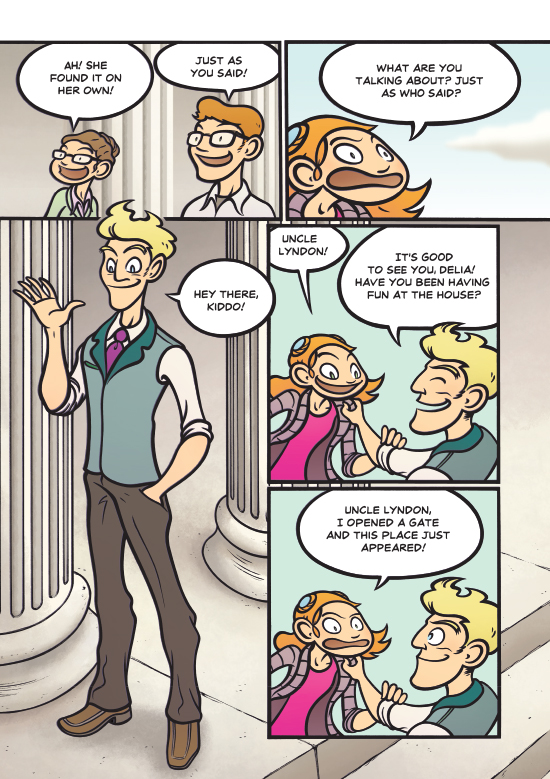
The Time Museum Interior Art by Matthew Loux
Paste: It seems like your work has undergone a shift to an intentional foregrounding of female characters. Accurate? Why?
Loux: For sure. SideScrollers’ main character was a fictional version of myself, a very safe way to start as a writer. Then Jack and Benny from the Salt Water Taffy series were boys and I think the only female character in it was their mom, so I purposefully wanted to focus on a female protagonist as well as her interactions with other girls for The Time Museum, mainly because I hadn’t before. I think I was feeling ready to try and write someone that is not my gender in a realistic way, where I may not have gotten it right in my 20s. Working out a character that seems different than you are can be intimidating, but the thing I always end up doing is putting myself in there. I think all of my characters are basically me, or my take on personalities I’ve known.
Paste: Is the 6th volume of Salt Water Taffy underway?
Loux: Nope, no plans. I would love to do more, but there isn’t any positive movement or interest from anyone for it right now.
Paste: [Cries a little about the previous answer] Your character designs are incredibly distinctive. Have you always drawn people the way you do?
Loux: Thank you. I’d say art is very evolutionary. If you look at SideScrollers vs. The Time Museum, I think you can see a similar feel, but at least to me they are so far from each other that I barely feel like the same artist. For The Time Museum I made a strong effort to improve my character designs and to really up my game on all aspects of my comic making. I wanted it to look like a beautifully animated movie. To be honest, part of it was an attempt to make my work look a little more accessible to a mainstream audience but only in a way I felt comfortable doing. Knowing that everything will be in color helped too, because it really brought life to my cartoony people in ways that had never before been realized.
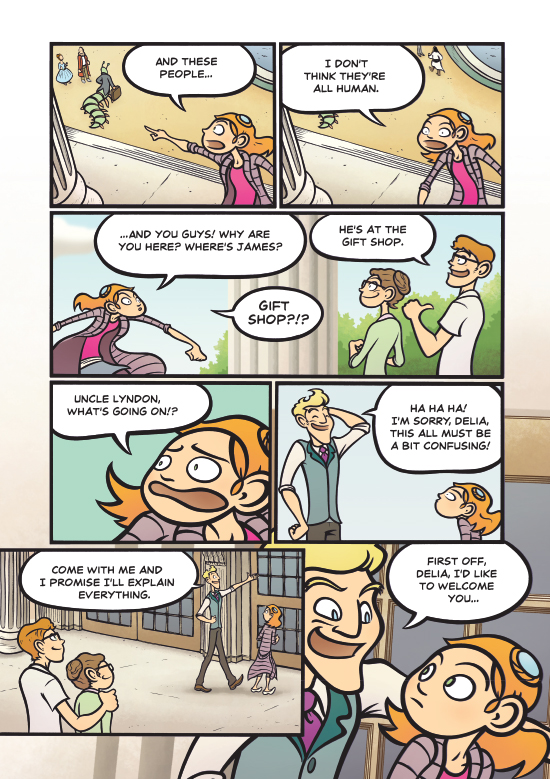
The Time Museum Interior Art by Matthew Loux
Paste: When you mention making your work look more accessible to a mainstream audience, what do you mean exactly (besides color vs. black and white)?
Loux: Color is a big part of it, but I guess I felt my work was getting too simplistic and the line art was getting too thick. Though I love how it looks, I think the Salt Water Taffy books were looking more like a throwback to older-looking comic art like Peanuts or Winsor McCay, even. My biggest influences on the look of that series were old Harper’s Weekly prints from the 19th century. The Time Museum needed to look more modern since it is a time-travel story. So I tried to describe their body forms, still within my style, only more accurately. No more spaghetti legs. Same with expressions, I gave them eyeballs instead of dots, and I tried to thin the lines down a bit. Also I had a lot of sharp points on my characters in my earlier work. I tried to eliminate that as much as I could and give everyone a softer feel. My art is definitely still cartoony, but their body language and the eyes in particular can convey emotion way better, which is essential since this is a more multifaceted story, I think.
Paste: What influences can you see on your visual style? I feel like your people are kind of Muppet-y, but maybe that’s just because they’re all mouth and eyes.
Loux: That’s hilarious. Definitely not intentional, though I do love the Muppets. I think my biggest influences these days are less about actual drawing style and more like an artistic feel and mood or an environmental clutter. [Studio] Ghibli movies have been a heavy one for me on this book, particularly regarding the color and the level of environment detail. But I think through all of my work, videogames from the ‘80s and ‘90s are by far my biggest source of inspiration and influence. I recently had a hard time explaining why to a friend who was a few years older than me, so I’m sure it has a lot to do with being an impressionable kiddo, but the artists who created those games did amazing things with little squares of only eight or 16 colors and I still get chills when I see some of them. It was also the first time you were able to literally control what you did in a story. You save the world or die and that was the story if you left it there. To a kid, that was pretty wonderful.
Paste: Do you still play videogames? Which ones?
Loux: I don’t have much time for it, but occasionally. My favorite game of the past 15 years was Fallout 3, I also enjoyed the two follow-ups to it. I played the Dragon Quest Monsters: Joker games, I love the Harvest Moon series. Right now I’m loving Stardew Valley, which is an indie game that is pretty much Harvest Moon if a fan lovingly made it in Super Nintendo graphics. But more often than not I go back and play through the NES, SNES and N64 games I played throughout my youth.
Paste: Is your cast of six teenagers in The Time Museum the same as originally conceived? In other words, how did you go about assembling them as a group and what changes did you make?
Loux: They came about pretty naturally, I think. Delia, the main character, obviously had to come from Brooklyn, NY (where I live), and the rest had to come from places in history I was interested in, but that also made up a nice variety of times giving them each a unique perspective on time travel. At the same time I crafted everyone’s character and temperament in a way that would always complement Delia’s by filling in the blanks of her own unique character shapes, particularly regarding the two other girls. Michiko, who is from Tokyo in the future, has a steady sense of self-esteem, where Greer, who is from medieval Scotland, has an over-the-top boldness. Both are traits that Delia has trouble with, but being around them helps bring them out. At the same time, Delia’s intelligence and steady way of thinking is what balances all of the other characters.
Paste: How do you feel about museums? This book seems to come from the perspective of “they’re exciting!” rather than “oh, man, please don’t take me there,” but maybe I’m wrong. What’s your favorite museum?
Loux: I love museums. The older I get, the more I appreciate them. I can’t say that was always the case, but as a kid I was brought to many so it must have made an impact on me. The American Museum of Natural History and the Metropolitan Museum of Art are absolutely tremendous, as is the British Museum and the Victoria and Albert Museum. I also really love the Brooklyn Museum because it’s more low-key than the ones in Manhattan. These ones I mentioned are all great for kids too, they are such bold and impressive places filled with so much cultural and historic stuff that it will always excite a kid’s imagination. And they are basically time machines.
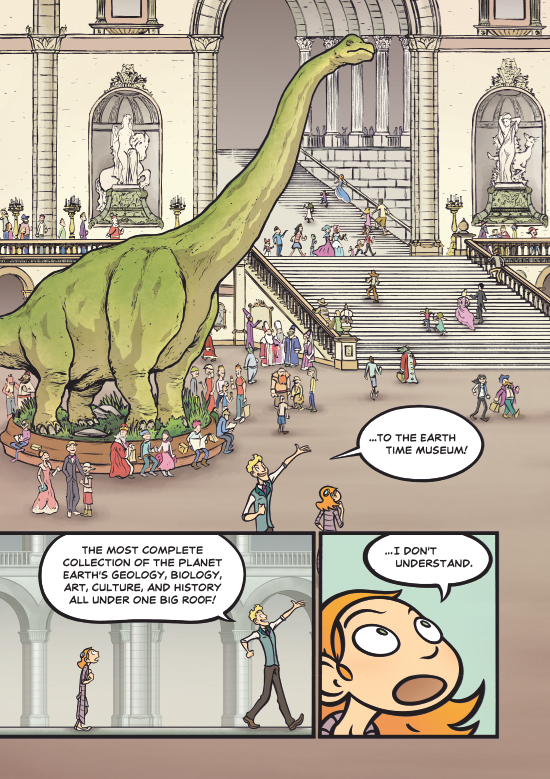
Paste: Here’s a question you’re probably going to get a lot: if you had your own time machine, where/when would you go?
Loux: Be happy you’re the first to ask. I would love to go to Japan both in the ‘90s and in the ‘60s. The ‘90s because that’s when I was starting to pay attention to the pop culture coming from there and I’d like to see the environment it all came out of. The ‘60s because it was their post-war economic miracle times. An amazing amount of innovation, culture, style and technology came from Japan during this time.
Paste: What do you think about life in our current era? More good than bad?
Loux: Both good and bad, like most eras, I guess. Good: technology that makes amazing things and lives better. Bad: politics of fear, division and hypocrisy. It’s actually tough to give a balanced answer to this question in the current political garbage fire we are entering.
Paste: Finally: favorite other works (not just comics but movies and books without pictures, etc., too) involving time travel? How about a top five or 10?
Loux: Back to the Future (my favorite movie of all time); Chrono Trigger, the amazing ‘90s JRPG for the Super Nintendo; Futurama, specifically the episodes that involved time travel and the movie, Bender’s Big Score; the original Time Machine, a classic movie and book; the final episode of Star Trek: The Next Generation; and also Star Trek IV: The Voyage Home.
